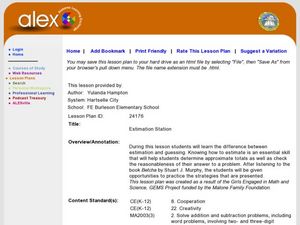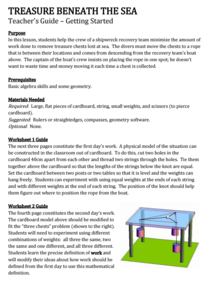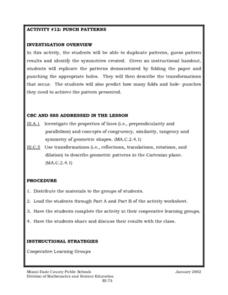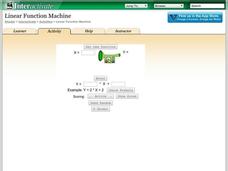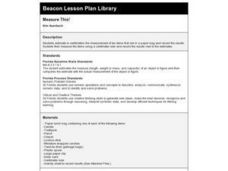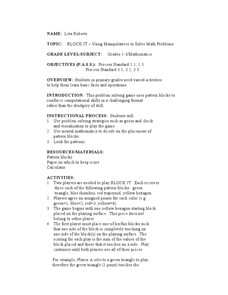Math Stars
Math Stars: a Problem-Solving Newsletter Grade 7
Put on your thinking caps because middle school math has never been more interesting in this huge resource full of thought provoking questions. Written as a newsletter, the resource has 10 two-page newsletters with a variety of...
Math Stars
Math Stars: a Problem-Solving Newsletter Grade 8
You've just hit the jackpot of integrating math problems and riddles with this jumbo-sized resource! Written as a newsletter, scroll through 35 pages of puzzles and quality problems to engage and encourage your learners to inquire...
EngageNY
Advanced Factoring Strategies for Quadratic Expressions (part 2)
What do you do with a difficult-to-factor quadratic expression? This lesson provides the answer. Pupils learn a grouping strategy to help factor trinomials. When guess and check seems too tedious, this method is the "works every...
Alabama Learning Exchange
Estimation Station: Why Estimating is Better than Guessing
Youngsters discover the difference between estimating and guessing. They estimate how many items are contained in a jar as they read a story. After the story, pupils discover the differences between estimating and guessing and create a...
Education Development Center
Language of Algebra
Don't rush into algebra, let learners visualize, guess, and predict their way to a successful math career. The introductory unit incorporates beginner algebraic concepts with shapes instead of variables. Young mathematicians use a...
California Mathematics Project
Treasure Beneath the Sea
Explore the geometry of treasure hunting! Learners use geometry to design a treasure recovery strategy. The objective is to create a design that minimizes the amount of work required. Budding mathematicians use properties of triangles as...
Curated OER
Systems of Linear Equations
Introduce the inverse matrix method to solve systems of linear equations both algebraically and graphically. Using given data, your class checks their answers with graphing calculators. Handouts are included in this well-thought out lesson.
Curated OER
Probability for the Novice
The comprehensive, overall purpose in teaching probability is to help students draw conclusions about the characteristics of a large group given a small sample taken from the group. Probability is related to predicting the chance of a...
Yummy Math
Penny Wars
As the saying goes, a penny saved is a penny earned. Young scholars use a penny activity to earn their way to an understanding of volume. Given three different-sized cylindrical containers, individuals make calculations to determine the...
Curated OER
Guess That Sequence!
Students analyze number sense by participating in a pattern identification activity. In this number sequence instructional activity, students examine several groups of numbers and identify the sequence in the group before adding on to...
EngageNY
The Zero Product Property
Zero in on your pupils' understanding of solving quadratic equations. Spend time developing the purpose of the zero product property so that young mathematicians understand why the equations should be set equal to zero and how that...
Curated OER
Solving Equations By Systematic Trial
Studentss solve equations using guess and check. In this algebra lesson, students solve linear equation using the systematic trial. They isolate and identify the missing variable using non tranditonal methods.
Curated OER
Relations
Students identify, compare, and analyze shapes and numbers. In this analogies and comparison math lesson plan, students warm up by completing 4 worksheets to familiarize themselves with analogies. In small groups, students are challenged...
Curated OER
Punch Patterns
Fifth graders duplicate patterns, guess pattern results and identify the symmetries created. They are given an instructional handout, 5th graders replicate the patterns demonstrated by folding the paper and punching the appropriate...
Shodor Education Foundation
Linear Function Machine
What goes in must come out! Learners play with a function machine to determine the correct function. They enter input values and watch as the machine produces the output.
101 Questions
Gas Station Ripoff
Ever wonder if you can trust the pump that pumps your gas? Budding mathematicians use video evidence to analyze the cost-per-gallon ratio at different intervals for three different pumps. Their goal is to identify the pump that is...
Curated OER
Guess the Age
Students rewrite word problems using symbols. In this algebra instructional activity, students rewrite equations graphically, algebraically and verbally. They relate the concepts to the real world.
Curated OER
Find It!
Students consturct cube trains and use them to measure the length of selected objects in their classroom. They first "guess" with their eyes and then hold up a cube to check their guess.
Curated OER
Investigation - What Does 1,000 Look Like?
Second graders determine what 1,000 items look like. In this math investigation lesson, 2nd graders collect 1,000 items and determine the best way to count them by tens and hundreds. They can use stickers on notecards to count to 1,000....
Curated OER
Estimation
Third graders gain an understanding of estimation as an educated guess. They explore measuring and how looking at various object size and shape can help form ones guess towards estimation. They use dinosaurs for an estimation activity.
Curated OER
Measure This!
Students estimate the measurement in centimeters for common classroom objects. They check their estimations, discuss the differences and write a paragraph summarizing the activity.
Curated OER
Block It: Using a Manipulative to Solve Math Problems
Students practice using visuals to solve math problems. In this math manipulative instructional activity, students utilize pattern blocks to participate in a class game in which geometric shapes touch other player's pieces. Students gain...
Utah Education Network (UEN)
Solving Single-Variable Equations Part II
Brainiacs explore the concept of solving single-variable equations.They use inverse operations to solve equations, and participate in activities such as balancing an equation scale. This is an awesome lesson, complete with game...
Curated OER
Estimation Contest
Learners explore the concept of estimation. In this estimation lesson, students estimate the number of Cheerios in their cup. Learners then determine the number of Cheerios in the entire box using what they know about their cup.



